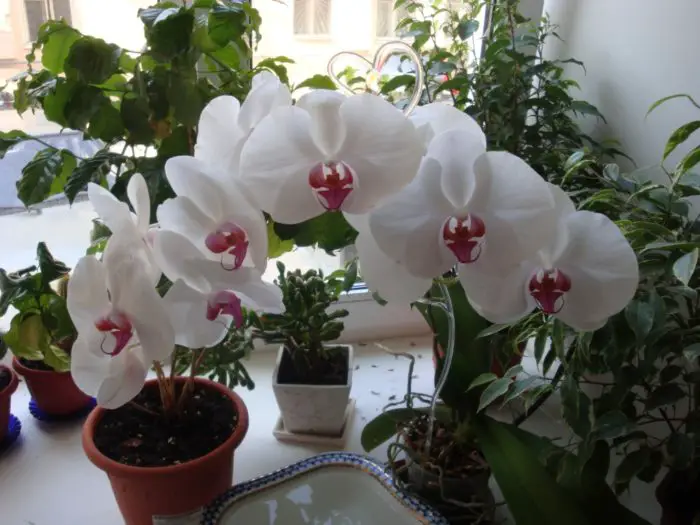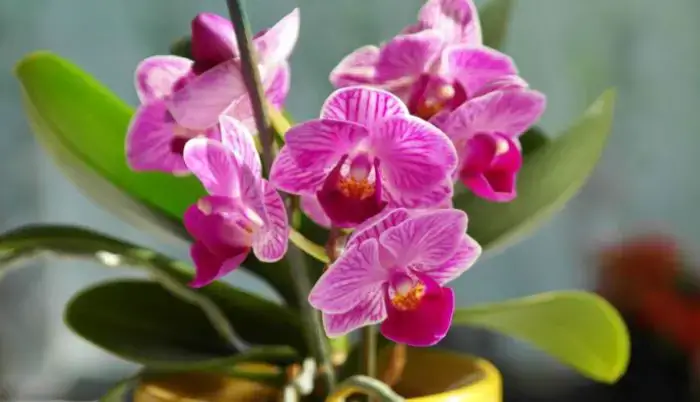
Growing orchids is fun. The plant looks especially beautiful during the flowering period. For the sake of this spectacle, this decorative culture is brought up. But it happens that flowers do not appear for a long time. To make a culture bloom, you must first find out the reason for the absence of buds and peduncles.
When Is The Orchid Ready To Bloom?
Usually, a flowering plant is purchased in the store this is the only way to determine the type, size and shade of the resulting flower. Since moving an orchid to a new room is always stressful, the first bloom usually does not last long. The peduncle, along with the buds, dries up and falls off, and the plant begins a period of relative dormancy.
The duration of this state depends on the variety acquired. The most frequent guests of this family on our windowsills are Phalaenopsis. They are not very demanding on the conditions of detention, therefore they are ready to bloom already 2-2.5 months after the last flowering.
In the meantime, the plant turns its main forces on the foliage: it forms new leaves and saturates them with green color. It is this saturation that is a kind of signal that the culture is ready to bloom.
Different types of decorative orchids prefer to do this at certain times of the year:
- Phalaenopsis and Pafidopellums usually form flower stalks in winter, from November to March;
- Cymbidiums and Dendrobiums – from October to February, but they also bloom in summer;
- the flowering period of Oncidiums begins in April and usually ends in June;
- Miltonias delight the eye in spring or autumn;
- Cattleya – from spring to the first days of winter.
IMPORTANT! Knowing such a biological calendar, you need to buy different types of orchids precisely during their traditional flowering period. Plants with a disturbed biological cycle are more likely to get sick and grow worse.
The flowering process itself can last from a month to six months. There are cases when buds periodically formed on one peduncle for 8-10 months.
See also Caring For Cattleya Orchids.
Why Orchid Growing New Leaves But Not Flowers?
So, we have decided on the rest period. But it happens that the time of flowering according to the natural schedule seems to have come, but there are no signs of peduncle formation. There may be several reasons for this. Orchid is a capricious culture and requires certain care rules.
Improper Watering
The orchid is watered in several ways. This can be surface watering from a watering can. Many people carry out it by immersion, lowering the flower pot for 15 minutes in a container of water. Through the drainage holes, water saturates the soil to the required consistency.
It is very important to comply with certain conditions of this procedure:
- over-watering is just as harmful as sparse watering. The substrate should be watered as it dries (usually 1-2 times a week), then the root system will be healthy and capable of nourishing flower stalks;
- cold water can chill the roots, from this they get sick, and the plant is no longer up to flowers. Water the flower with warm, settled water;
- if water enters the leaf axils during irrigation, from where the peduncles begin to grow, it stagnates there. The process of decay begins, flowering is out of the question.
IMPORTANT! Excessive watering is harmful for two reasons: it activates the growth of leaves to the detriment of peduncles and leads to the decay of the roots. And in fact, and in other cases, the orchid will not be able to bloom.
The decay process can be identified by the color of the roots. In affected plants, they begin to darken.
Unsuitable Growing Medium
Phalaenopsis is the most common and unpretentious type of orchid. But they are also very demanding on the composition of the substrate the soil in which the plant is grown. You can buy it at a specialty store, but it is quite possible to make the mixture yourself. Here is one such recipe.
The following components are required for the substrate:
- bark of coniferous trees, larch or oak; you just need to make sure that there is no resin on it;
- agroperlite is a porous substance of volcanic origin; does not nourish the plant, but protects against rot;
- sphagnum moss – it is quite suitable collected on wet soil in the forest;
- peat with sand particles;
- coconut fiber.
Such a composition forms a porous nutrient soil, where the roots of the plant will freely develop and be saturated with oxygen.
IMPORTANT! It’s just that forest soil or flower shop soil is not suitable for orchids, they are too dense. The delicate roots of Phalaenopsis are not able to develop and breathe there.
It is clear that an underdeveloped root system will not contribute to the formation and growth of peduncles. In dense soil, they begin to die off very quickly.
Read also ideal humidity for phalaenopsis orchids.
Constant Changing Place
Orchids do not tolerate any movement well, so it is often not worth doing this. In nature, such flowers grow all their lives in one place, and therefore they bloom profusely.
You should limit yourself to the following principles:
- closer to winter, it is permissible to move the flower to a cooler and shaded place;
- you can rearrange the pot after transplanting – the culture will still adapt to new conditions;
- Phalaenopsis are sensitive to changes in lighting conditions (even minor ones); moving from windowsill to windowsill will force the plant to throw all its strength into adaptation, and not on the formation of a peduncle.
Insufficient Light
An immutable rule: an orchid will never bloom in low light conditions. Other conditions must also be met:
- the light should be diffused, like in a tropical forest;
- direct sunlight in summer can cause leaf burns, there will no longer be a peduncle in their axils;
- if flowering is expected in winter, it is necessary to prolong the natural light with the help of additional lighting, otherwise the buds will not form.
Incorrect Temperature Conditions
The conditions of detention should be as follows:
- in summer, temperatures from 15 to 30 degrees are permissible;
- in winter – from 20 to 23 ° C;
- for the period of peduncle formation, it is necessary to ensure a difference between night and day temperatures of 5-7 degrees; the process will take place in conditions close to natural, which will be the most suitable regime for the orchid.
Orchid Growing New Leaves But Not Flowers: Best Treatment Methods

After correcting all possible errors in the maintenance of orchids, you can begin to create optimal conditions for the beginning of flowering. There are several options for stimulating the plant that are not particularly difficult.
Creation Of Optimal Conditions
With the right soil, watering, and temperature conditions, it remains to take care of a few more conditions necessary for the flowering of an orchid:
- Phalaenopsis blooms best on the south side, only it should be slightly shaded;
- the most suitable flowerpots are transparent, they show the condition of the roots;
- the daytime temperature regime should be observed in the region of 22 degrees, the nighttime temperature regime should be reduced to 15; in the summer, the pet can be taken out on the balcony at night;
- regular feeding of the plant with drugs bought in the store should be organized; fertilization is stopped with the beginning of flowering.
IMPORTANT! For the formation of a peduncle, it is necessary to create conditions for the culture that are as close to natural as possible. Then the flowering will belong.
The age of the flower is also of great importance if you grow it yourself. In different varieties, the first formation of peduncles varies from 1.5 to 3 years. Usually, by this time, 5-7 full-fledged leaves are already formed on the plant.
Drought Simulation
Sometimes you have to resort to more drastic measures. Most wild orchids are native to the tropics, where heavy rains give way to drought. You can simulate drought and at home by reducing watering by about 2 times and completely removing top dressing. Under these conditions, the flower usually begins to form peduncles, feeling the lack of the usual comfort.
Further, the process will go like this:
- artificial drought will reduce the nitrogen content in the substrate, which causes the growth of leaves, but not flowers;
- the process of “education” can last up to a week, however, provided that the room is not higher than 30 degrees;
- you do not need to spray the plant at this time either;
- after the appearance of the first arrow, watering is resumed, but without feeding.
IMPORTANT! This method is only suitable for absolutely healthy specimens. A weak flower may die due to lack of moisture and overdried substrate.
The method should be applied only with careful observation of the “pet”. At the first signs of the lethargy of the flower, watering is transferred to the usual mode.
We have an interesting guide on How To Build An Orchid Greenhouse?
Warm Shower
To carry out this procedure, you need to heat the water to 40 degrees and spray the plant. The features of the process are as follows:
- The substrate is first covered with polyethylene.
- The pot is placed in the bath and sprayed abundantly.
- Then leave to dry completely.
IMPORTANT! Hot tap water cannot be used, it contains impurities that can harm the culture.
Processing is carried out in approximately 15 seconds. If necessary, repeat it after 10 days.
Simulated Rainy Season
The stimulation goes like this:
- water is heated to 30-35 ° C;
- abundant watering is carried out within 3-4 days;
- then any irrigation is stopped for 2 weeks.
Orchid Not Blooming
There are several more reasons why flowering may not occur. All of them are somehow related to the conditions of detention.
Orchid Has Not Bloomed In Year
Sometimes a flower needs to be literally woken up by an abrupt change in conditions. But there may be other reasons:
- there will be no peduncles even after another year if there is fresh bark, sawdust, and especially fresh manure in the substrate;
- the lack of aerial roots also inhibits growth and flowering;
- the orchid does not bloom if it does not have enough feeding.
Orchid Stopped Giving Buds
The reasons may be as follows:
- flower stalks without buds grow due to lack of light;
- this usually happens due to a lack of moisture;
- buds fall off due to excessive fertilization.
Orchid Growing Leaves Not Flowers
This phenomenon also happens often:
- the situation can be provoked by an excess of fertilizers;
- often the container with the substrate is too spacious, the roots and leaves are not limited in growth;
- The most common reason for excessive leaf growth is that there is a lot of nitrogen in the substrate, and the grower needs to choose another top dressing with a low substance content.
Correct and competent care, the caring attitude of the grower to the orchid will allow you to enjoy the beautiful flowering of the exotic “guest” for a long time.
Conclusion
Why do orchid growing leaves not flowers? This is because orchids are extremely sensitive to their environment and require specific conditions in order to bloom. By understanding the conditions necessary for orchid blooming, you can create the perfect environment for your orchids and ensure that they grow leaves instead of flowers.
